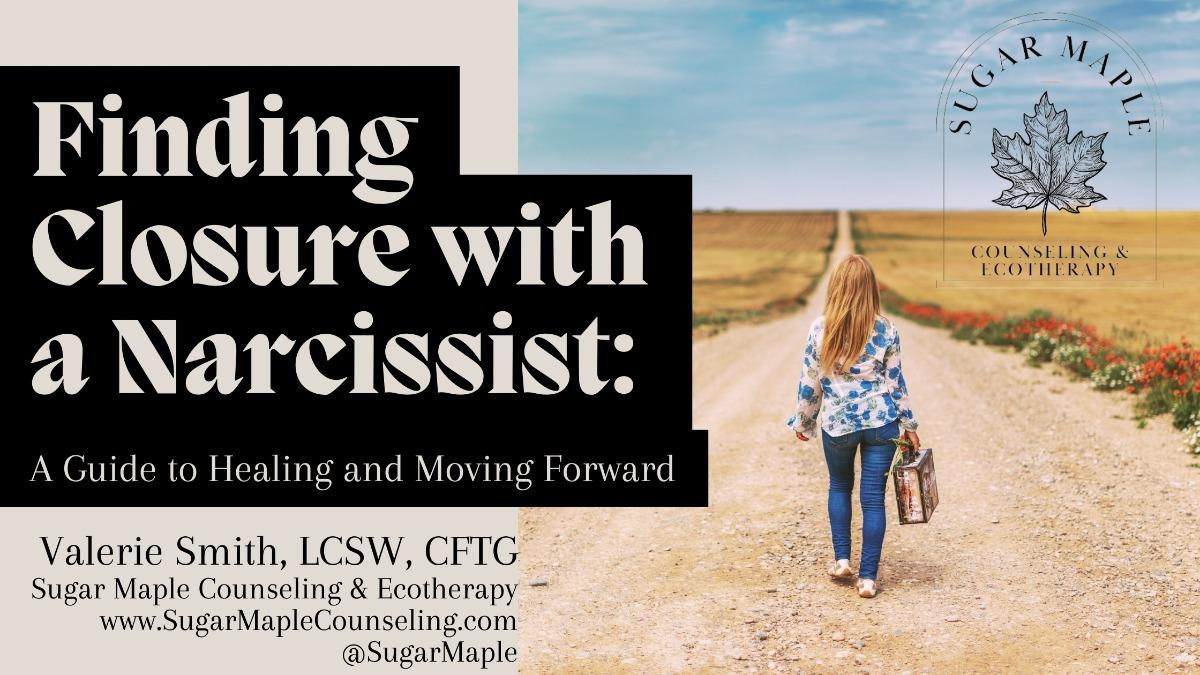Finding Closure with a Narcissist: A Guide to Healing and Moving Forward

- posted: Jul. 23, 2024
Finding Closure with a Narcissist:
A Guide to Healing and Moving Forward
Breaking up with a narcissist and recovering from narcissistic abuse is a deeply challenging experience that often leaves victims feeling disoriented and emotionally drained. Narcissists are adept at manipulating and controlling, making it hard to find closure and move forward. However, there are strategies to help you heal and reclaim your peace. Here are some effective ways to find closure, including the use of the gray rock and yellow rock techniques.
1. Accept the Reality of the Relationship
The first step towards closure is accepting the truth about the relationship. Acknowledge that the narcissist's behavior was abusive and manipulative, and understand that their actions were a reflection of their own issues, not your worth. This realization is crucial for letting go of any lingering hope or guilt.
2. Go "No Contact" or Low Contact
To heal, you need distance from the narcissist. Implementing a no-contact rule is the most effective way to break free from their influence. This means cutting off all communication and social media connections. If no contact is impossible due to shared responsibilities, such as co-parenting, opt for low contact and use techniques to minimize interactions. Two powerful techniques for low contact include the gray rock and yellow rock techniques.
3. Utilize the Gray Rock Technique
The gray rock technique involves making yourself uninteresting and unresponsive to the narcissist’s attempts at manipulation. It is called the gray rock technique because it implies you will appear boring and unappealing like an average gray rock. By giving bland, minimal responses, you reduce their interest in engaging with you. This technique helps you maintain emotional distance and protects your mental health.
- Example: If the narcissist tries to provoke you with a controversial topic, respond with a neutral comment like, “I see.”

4. Implement the Yellow Rock Technique
The yellow rock technique is about being polite and firm while limiting personal engagement. This is especially useful in unavoidable interactions, such as co-parenting. Remain calm, consistent, and respectful without sharing personal details or engaging emotionally. This is called the yellow rock technique because a yellow rock is slightly more interesting than a gray rock, but it is not desirable like a gemstone.
- Example: Respond to a narcissist’s text about logistics with, “Thank you for the update. I’ll pick up the kids at 5 PM as agreed.”
5. Seek Professional Support
Therapy can be immensely helpful in processing the trauma of narcissistic abuse and finding closure. A therapist who specializes in narcissistic abuse recovery can provide guidance, validate your experiences, and equip you with coping strategies.
6. Build a Support Network
Surround yourself with people who understand and support you. Friends, family, and support groups can offer emotional validation and encouragement as you navigate your healing journey. Sharing your experiences with others who have gone through similar situations can be particularly empowering.
7. Engage in Self-Care
Prioritizing self-care is essential for healing. Engage in activities that nurture your physical, emotional, and mental well-being. This could include regular exercise, healthy eating, mindfulness practices, journaling, and pursuing hobbies that bring you joy.
8. Reclaim Your Identity
Narcissistic relationships often strip victims of their sense of self. Rebuilding your identity involves rediscovering your interests, values, and passions. Reflect on what makes you unique and set new goals for your personal growth.
9. Practice Self-Compassion
Be gentle with yourself as you heal. Understand that recovery is not linear, and it is normal to have setbacks. Treat yourself with the same kindness and understanding that you would offer to a loved one.
10. Educate Yourself
Knowledge is empowering. Learn about narcissistic personality disorder and the tactics narcissists use. This understanding can help you recognize and avoid future manipulative relationships and empower you to make informed decisions.
11. Develop Healthy Coping Strategies
Having effective coping strategies can help you manage the emotional aftermath of narcissistic abuse. Techniques such as deep breathing, mindfulness, and grounding exercises can help you stay calm and centered when memories or triggers arise.
12. Create New Boundaries
Establishing and maintaining boundaries is crucial for your ongoing well-being. Learn to say no and protect your personal space and time. Healthy boundaries will help you build relationships based on mutual respect and trust.
Final Thoughts
Finding closure after narcissistic abuse is a challenging but achievable journey. By accepting the reality of the relationship, seeking support, setting boundaries, and using techniques like gray rock and yellow rock, you can begin to reclaim your peace and rebuild your life. Remember, you deserve to live a life free from manipulation and full of genuine, supportive relationships. Be patient with yourself and celebrate each step you take towards healing and closure.

- posted: Jul. 23, 2024
Finding Closure with a Narcissist:
A Guide to Healing and Moving Forward
Breaking up with a narcissist and recovering from narcissistic abuse is a deeply challenging experience that often leaves victims feeling disoriented and emotionally drained. Narcissists are adept at manipulating and controlling, making it hard to find closure and move forward. However, there are strategies to help you heal and reclaim your peace. Here are some effective ways to find closure, including the use of the gray rock and yellow rock techniques.
1. Accept the Reality of the Relationship
The first step towards closure is accepting the truth about the relationship. Acknowledge that the narcissist's behavior was abusive and manipulative, and understand that their actions were a reflection of their own issues, not your worth. This realization is crucial for letting go of any lingering hope or guilt.
2. Go "No Contact" or Low Contact
To heal, you need distance from the narcissist. Implementing a no-contact rule is the most effective way to break free from their influence. This means cutting off all communication and social media connections. If no contact is impossible due to shared responsibilities, such as co-parenting, opt for low contact and use techniques to minimize interactions. Two powerful techniques for low contact include the gray rock and yellow rock techniques.
3. Utilize the Gray Rock Technique
The gray rock technique involves making yourself uninteresting and unresponsive to the narcissist’s attempts at manipulation. It is called the gray rock technique because it implies you will appear boring and unappealing like an average gray rock. By giving bland, minimal responses, you reduce their interest in engaging with you. This technique helps you maintain emotional distance and protects your mental health.
- Example: If the narcissist tries to provoke you with a controversial topic, respond with a neutral comment like, “I see.”

4. Implement the Yellow Rock Technique
The yellow rock technique is about being polite and firm while limiting personal engagement. This is especially useful in unavoidable interactions, such as co-parenting. Remain calm, consistent, and respectful without sharing personal details or engaging emotionally. This is called the yellow rock technique because a yellow rock is slightly more interesting than a gray rock, but it is not desirable like a gemstone.
- Example: Respond to a narcissist’s text about logistics with, “Thank you for the update. I’ll pick up the kids at 5 PM as agreed.”
5. Seek Professional Support
Therapy can be immensely helpful in processing the trauma of narcissistic abuse and finding closure. A therapist who specializes in narcissistic abuse recovery can provide guidance, validate your experiences, and equip you with coping strategies.
6. Build a Support Network
Surround yourself with people who understand and support you. Friends, family, and support groups can offer emotional validation and encouragement as you navigate your healing journey. Sharing your experiences with others who have gone through similar situations can be particularly empowering.
7. Engage in Self-Care
Prioritizing self-care is essential for healing. Engage in activities that nurture your physical, emotional, and mental well-being. This could include regular exercise, healthy eating, mindfulness practices, journaling, and pursuing hobbies that bring you joy.
8. Reclaim Your Identity
Narcissistic relationships often strip victims of their sense of self. Rebuilding your identity involves rediscovering your interests, values, and passions. Reflect on what makes you unique and set new goals for your personal growth.
9. Practice Self-Compassion
Be gentle with yourself as you heal. Understand that recovery is not linear, and it is normal to have setbacks. Treat yourself with the same kindness and understanding that you would offer to a loved one.
10. Educate Yourself
Knowledge is empowering. Learn about narcissistic personality disorder and the tactics narcissists use. This understanding can help you recognize and avoid future manipulative relationships and empower you to make informed decisions.
11. Develop Healthy Coping Strategies
Having effective coping strategies can help you manage the emotional aftermath of narcissistic abuse. Techniques such as deep breathing, mindfulness, and grounding exercises can help you stay calm and centered when memories or triggers arise.
12. Create New Boundaries
Establishing and maintaining boundaries is crucial for your ongoing well-being. Learn to say no and protect your personal space and time. Healthy boundaries will help you build relationships based on mutual respect and trust.
Final Thoughts
Finding closure after narcissistic abuse is a challenging but achievable journey. By accepting the reality of the relationship, seeking support, setting boundaries, and using techniques like gray rock and yellow rock, you can begin to reclaim your peace and rebuild your life. Remember, you deserve to live a life free from manipulation and full of genuine, supportive relationships. Be patient with yourself and celebrate each step you take towards healing and closure.

